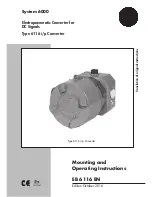
D-43
Parameter Reference
AC30V series Variable Speed Drive
V/F Shape
The function allows the user to parameterise the Drive’s conventional V/F motor fluxing scheme. Four V/F shapes are available, LINEAR LAW,
FAN LAW, USER DEFINED, and APPLICATION DEFINED:
Linear Law V/F shape should be used in applications requiring constant motor torque though out the speed range (e.g. machine tools or
hoists).
Fan Law V/F shape provides less torque capabilities for lower speeds, which means some energy savings can be achieved for fan or
pump applications when they operate at lower speed/load setpoints. When choosing fan law shape the user should carefully consider if
such profile is suitable for the overall load cycle of their application.
User Defined V/F shape provides a method for the user to define any profile. 10 user definable (x,y) points are provided. Linear
interpolation is used between each point. The drive also assumes the following points - (0%,0%) and (100%,100%) - though these may
be overridden. For example, (USER FREQ 1 = 0%, USER VOLTAGE 1 = 5%) takes precedence over (0%, 0%).
Application Defined V/F shape provides a method for the user to define any fluxing profile within the application layer. In the application
the user can set desired voltage level for any operating frequency, and the application will dynamically provide that value to the firmware,
via the “Application Volts” parameter. If this mode is used, it is recommended that such application is executed in 1ms time frame.
For any of these V/F shapes the
Base Frequency
parameter (in the
Motor Nameplate
function) which is the value of Drive output frequency at
which maximum output volts is provided, can be set by the user.
Boost Parameters
Correct no-load motor fluxing at low Drive output frequencies can be achieved by setting the
Fixed Boost
parameter.
Correct motor fluxing under load conditions is achieved by setting the
Auto Boost
parameter. The motor is correctly fluxed when the
Actual Field Current
diagnostic in the
Feedbacks
function reads 100.0% .
Additional
Fixed
Boost
can be applied during acceleration by setting the
Acceleration Boost
parameter. This can be useful for starting
heavy/high stiction loads.
Saving Energy
An
Energy Saving
mode is provided to allow the user to choose to optimize energy consumption under low load conditions in steady state. As
soon as the load is increased or acceleration is required, the drive suspends energy saving mode, and returns to it only if the load conditions are
such that it is allowed to do so. If enabled, energy saving mode is reducing the voltage of the motor to a level required to maintain specific
setpoint speed at a particular low load. For sustained low load conditions it is not necessary to keep the motor fluxed for rated torque capabilities,
so the motor voltage is reduced to a level that will still provide required torque, but not much more torque. This operation on the cusp of required
torque is also the biggest weakness of energy saving mode. Energy saving procedure does monitor torque demand and as soon as it detects its
rise the drive switches from energy saving mode to normal mode of operation. However, sudden increases in load may be too quick to be dealt
with by energy saving mode, and may lead to stall or trip conditions. This will occur if the time to correctly re-flux the motor takes longer than the
time of load increase, when there can be a window of time when the motor is simply not able to generate sufficient torque necessary for the new,
increased load conditions. For this reason the user has to be very careful when choosing to utilize energy saving mode.
Energy saving mode should ideally be used in applications where there are prolonged periods of low load operation, with no fast excursions
towards rated torque. The user always has to be certain that the overall load cycle for their application would still be correctly serviced if the
energy saving mode is enabled, and that energy saving mode is not being incorrectly used at the expence of required performance.
















































